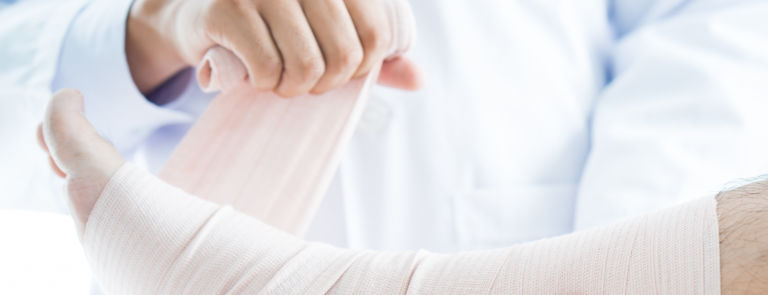15% off €25
Sprain vs strain – What’s the difference?

Sprain and strains can both be pretty painful, but what’s the difference? People often use these words interchangeably, but they’re not quite the same.
Both sprains and strains are classed as soft tissue injuries, but the tissues they affect are different.
What is a sprain?
- A sprain is a stretch or tear in a ligament, which are the tough bands of tissues connecting your bones together.
What is a strain?
- A strain is a stretch or tear in a muscle or tendon. A tendon is the flexible tissue which connects muscles to bone.
What’s the difference between a sprain and a strain?
The key factors which distinguish the two are as follows:
-
The injured tissue
The main difference is that a sprain affects the ligaments – while a strain affects the muscles or tendons.
Ligaments are made of tough connective tissue incorporating collagen fibres and elastin.1
Muscles are made of myofibers – protein-packed muscle cells.2 These are designed to stretch, but overstretching is what causes strains. Tendons are similar to ligaments in that they are made of tough collagen fibres, but they have a richer blood supply than ligaments.
-
Healing time
Sprains can take longer to heal than strains.
Ligament injuries usually take around 12 weeks to heal.3
Muscles and tendons have a richer blood supply than ligaments, making them a faster-healing tissue. sprains.4
A muscle strain heals within 2 – 4 weeks, with a tendon strain taking up to 6 weeks to heal.5
-
The location
You can get a sprain anywhere you have ligaments – so around any joint. Common areas where people get sprains include wrists, ankles, knees and thumbs.
Strains are common around major muscle groups, such as in the back, calves or hamstrings (at the back of the legs).
-
The cause
Twisting a knee or ankle, falling on an elbow, or anything else that forces your joint out of position can cause a sprain.6
Muscle or tendon strains can happen suddenly or develop over a few days or weeks. They can be caused by a recent injury, overstressing the muscles (i.e. during a high-intensity workout) or lifting heavy objects.
Moving the same muscles or tendons in the same way repeatedly can cause chronic strains, or repetitive strain injury (RSI).7
Summary
- A sprain is a stretched or torn ligament – the tough bands of tissue which hold bones together.
- A strain is a stretched or torn muscle or tendon. Tendons are the elastic tissue which connect muscles to bones.
- Sprains take longer to heal as ligaments are less vascular.
Symptoms of sprains and strains
Both sprains and strains are defined using 3 degrees of severity:8
-
Grade 1
A Grade 1 sprain or strain is where the ligament (in the case of sprains) or muscle or tendon (in the case of strains) is stretched, but not torn.
There may be slight swelling, but barely obvious. There may be a loss of the range of motion of the joint or muscle (ability to move in various directions) and strength (0 – 25%).
If the affected area is a joint - it will remain stable with a Grade 1 sprain or strain.
-
Grade 2
A Grade 2 sprain or strain is when the ligament (in the case of sprains) or muscle or tendon (in the case of strains) is stretched and somewhat torn.
There may be more noticeable swelling around the joint or muscle group. You may also see bruising.
There will be more pronounced loss of range of motion, (25 – 75%).
If the affected area is a joint, it may have some loss of stability.
-
Grade 3
A Grade 3 sprain or strain is when the ligament (in the case of sprains) or muscle or tendon (in the case of strains) is completely torn.
There will be significant swelling around the site of the injury, as well as bruising.
There will be a significant loss of motion, (75% - 100%).
You will experience a significant loss of stability of the joint or area.
Summary
- Both sprains and strains are categorised by severity as Grade 1, Grade 2 and Grade 3
- Grade 1 is generally mild, whereas Grade 3 means significant tearing of the ligament, muscle or tendon
How to treat a sprain or strain
Whether you have a sprain or strain, the treatment approach should be the same.9 Many healthcare experts recommend the RICE method – Rest, Ice, Compress and Elevate.10
-
Rest
Don’t put any weight on the injured area. Stop the activity which caused you to injure yourself in the first place, whether that’s tennis, walking or lifting boxes, and don’t resume the activity until your injury has healed.
Continuing to use the injured body part can exacerbate the grade of severity of the sprain or strain.
If your injury is on the ankle or knee, your doctor may recommend that you use crutches.
-
Ice
As soon as possible following your injury, apply an ice pack for up to 20 minutes every 2 to 3 hours.
You could use an unopened bag of frozen vegetables, or ice cubes wrapped in a bag or towel. Don’t put ice directly on the skin.
Ice reduces inflammation in the injured soft tissues and minimises pain and swelling.
However, it’s worth noting that although icing a soft tissue injury like a sprain or a strain does work for reducing swelling, it may not be the best thing for a speedy recovery.
Some medical professionals now believe that ice may actually slow the healing process by acting as a vasoconstrictor – constricting the blood vessels. This is great for reducing swelling but reducing the blood flow to an area can slow soft tissue healing.11
-
Compress
Slightly compressing a sprain or strain may help reduce the swelling of the area. Ensure any wrapping isn’t too tight, as this can have the opposite effect and make swelling worse.
Keep the compression on the affected area during the day, but remove at night for up to 3 days. By then, the swelling should have reduced – if not, consult your doctor.12
The most common compression method is an elasticated bandage. In some cases, a cast, boot, or splint may be required (your doctor will tell you which one is right for your injury).
-
Elevate
Keeping a soft tissue injury elevated above heart-height may help reduce the swelling and pain in the affected area.
Interestingly, a 2012 review found little benefit in elevation for healing an ankle sprain, although elevation is beneficial for reducing the blood pressure in the affected area and any subsequent bleeding.13
Many people also find that elevating an injury can reduce pain.
-
Take painkillers
Taking an over-the-counter painkiller such as ibuprofen or paracetamol may help with the pain of a new sprain or strain injury.14
Don’t take ibuprofen for 48 hours after your injury as it may slow down healing.15
Over-the-counter painkillers should be a short-term measure to manage pain. If the pain doesn’t subside, consult a medical professional.
-
Move
Although the common medical advice is to rest a sprain or strain, it’s also believed that movement can help speed the recovery process.
One study looked at 101 people with Grade 1 and Grade 2 ankle sprains. Half of them followed the standard Rest, Ice, Compression and Elevation advice, while the other group followed a therapeutic exercise programme.
It was found that staying active with exercises such as walking and stepping during the first week after the ankle sprain actually improved ankle function, without any increase in pain or swelling.16
This study didn’t test Grade 3 sprains, or any strenuous exercise e.g. running, so stay away from the active approach if your injury is particularly swollen or bruised, and don’t perform any high-intensity exercise.
We advise to only move an injury if it doesn’t cause any major discomfort or pain when weight-bearing.
-
Range-of-motion exercises
To help restore functionality to the sprained or strained area, you should perform some gentle exercises with the affected limb.
In the case of an injured wrist, ankle, finger or elbow (common locations for sprains and strains), gently flex the joint back and forth, as well as in circular motions.17 This increases flexibility and will prevent stiffness in the area.18
You should begin these exercises within 48 hours of your injury, so long as it’s not significantly swollen or bruised. If you think you may have broken a bone, seek immediate medical attention.
-
Strengthening
As your healing progresses, you should introduce some exercises to restore strength to the muscles in that area. This can help support your ligaments, muscles and tendons and help prevent re-injury.
Strengthening exercises include (for the legs, feet and ankles) stretching your foot out in front of you supported by a band on the ball of the foot (a tea towel will do). Slowly pull the band towards you so your toes come towards you and you feel a stretch in the sole.19
Another strengthening exercise for sprained or strained legs, feet or ankles involves rising onto the balls of your feet, holding the position and slowly lowering your feet back to a flat position. This strengthens the muscles supporting your ankle.20
Begin strengthening exercises around 3 – 4 weeks after the initial injury.
-
Massage
Massage is excellent for boosting blood flow, which can help with the healing process by delivering oxygen and nutrients essential for tissue repair to the injured site.21,22
We recommend waiting until the initial swelling has subsided before commencing massage on a sprain or strain, and don’t massage the affected joint directly. Listen to your body – if it feels wrong, don’t do it.
When should you see your doctor for a sprain or a strain?
It’s important to know when your injury can’t be treated with home care. If you can’t bear weight on it at all, this is a sign you might have broken a bone and should have an X-ray.23
If there is excessive swelling, numbness, bleeding or visible misalignment of a joint, seek medical attention as this could also signify a broken bone.
If a sprain or strain hasn’t improved in around 4 – 6 weeks, see your GP. They may be able to refer you to a physiotherapist.24
Summary
- Rest, Ice, Compression and Elevation (RICE) has been the gold standard advice for sprains and strains for many years
- Newer research suggests staying active and massage can help mild to moderate sprains and strains
- If you can’t bear weight on the injury, it’s excessively swollen or looks misaligned, seek medical attention
Last updated: 2 July 2021
- https://www.orthobullets.com/basic-science/9016/ligaments
- https://www.hindawi.com/journals/tswj/2016/3182746/
- https://symmetryptaustin.com/healing-expectations-for-different-tissue-types/
- https://symmetryptaustin.com/healing-expectations-for-different-tissue-types/
- https://symmetryptaustin.com/healing-expectations-for-different-tissue-types/
- https://www.niams.nih.gov/health-topics/sprains-and-strains#tab-causes
- https://www.nhs.uk/conditions/repetitive-strain-injury-rsi/
- https://www.nationwidechildrens.org/specialties/sports-medicine/sports-medicine-articles/the-sprains-and-strains-of-sporting-injuries-article
- https://www.niams.nih.gov/health-topics/sprains-and-strains#tab-treatment
- https://www.nhs.uk/conditions/sprains-and-strains/
- https://www1.racgp.org.au/newsgp/clinical/is-it-time-to-rethink-rice-for-soft-tissue-injurie
- https://www.uofmhealth.org/health-library/tw4354spec
- https://www.ncbi.nlm.nih.gov/pmc/articles/PMC3396304/
- https://www.nhs.uk/conditions/sprains-and-strains/
- https://www.nhs.uk/conditions/sprains-and-strains/
- https://pubmed.ncbi.nlm.nih.gov/20457737/
- https://www.health.harvard.edu/pain/recovering_from_an_ankle_sprain
- https://www.ouh.nhs.uk/patient-guide/leaflets/files/12384Pankle.pdf
- https://www.ouh.nhs.uk/patient-guide/leaflets/files/12384Pankle.pdf
- https://www.health.harvard.edu/pain/recovering_from_an_ankle_sprain
- https://pubmed.ncbi.nlm.nih.gov/2223323/
- https://www.physio.co.uk/treatments/massage/benefits-of-massage/improved-circulation.php
- https://www.nationwidechildrens.org/specialties/sports-medicine/sports-medicine-articles/the-sprains-and-strains-of-sporting-injuries-article
- https://www.nhs.uk/conditions/sports-injuries/



